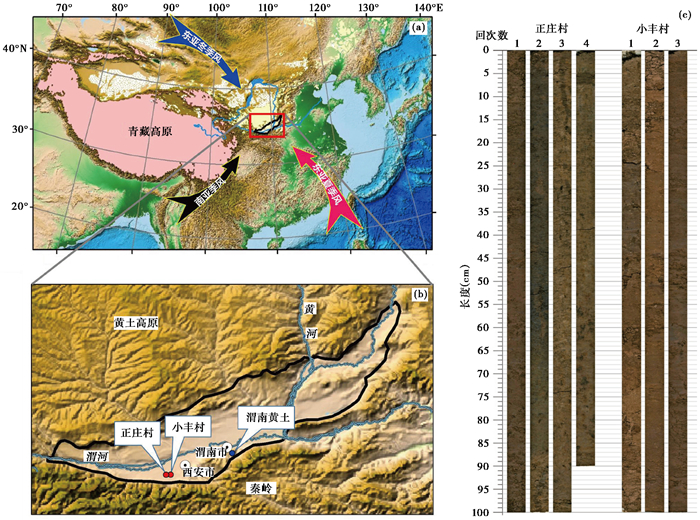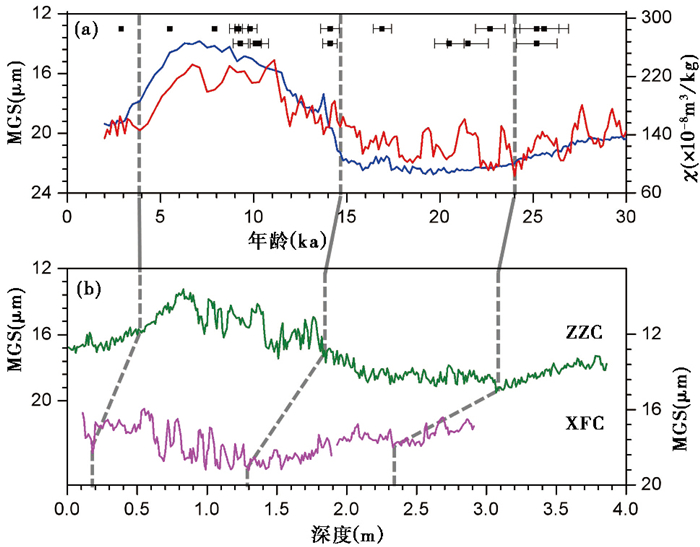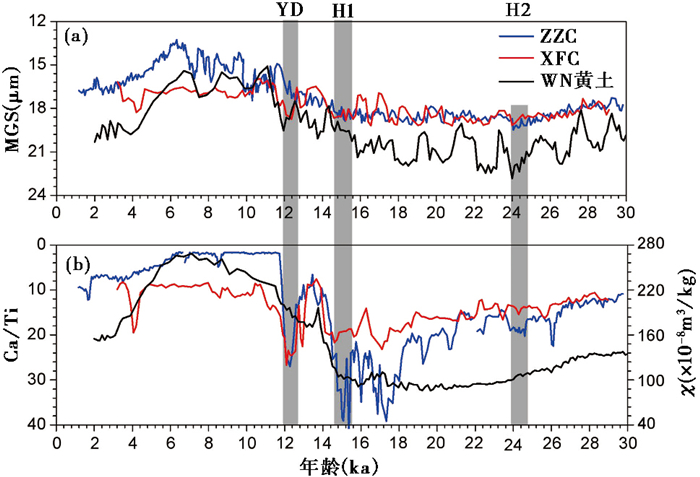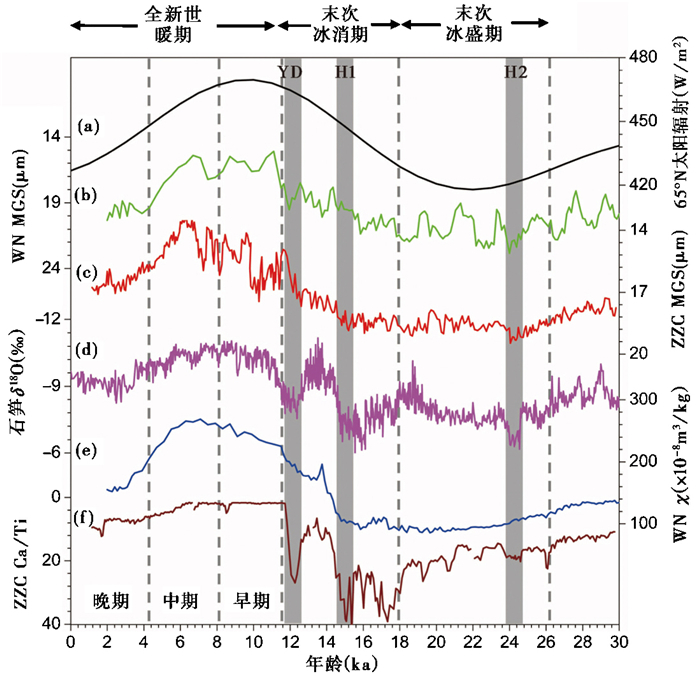2 中国科学院大学, 北京 100049;
3 中国科学院第四纪科学与全球变化卓越创新中心, 陕西 西安 710061;
4 西安交通大学全球变化研究院, 陕西 西安 710054)
第四纪环境演化是古气候研究的重要内容,尤其是近数万年来的气候演化特征及该期间发生的短尺度、快速变化的气候突变事件,它们与人类生存和文明演进息息相关,受到广泛的关注。其中,末次冰盛期(Last Glacial Maximum,简称LGM)到全新世温暖期是距离现在最近的一次显著增温期,可视为未来气候变化的历史相似型[1~2],因此,研究LGM以来的区域气候(水热)变化对全球变暖背景下的未来气候预测有很大意义。LGM时期主要表现为全球冰量大幅度增加[3~4]、海平面下降[5~7]、亚洲季风减弱[8~11]等气候特征,全球众多海洋[12~13]、冰芯[6, 14~15]、沙漠和黄土[16~17]、石笋[18~19]、湖泊[20]等沉积均有记录。该时期冰川积累到最大,之后发生了大规模的冰消(末次冰消期),期间出现了若干次千年尺度的气候波动,包括Heinrich 1(H1)冷事件[21]、Bølling-Allerød(BA)暖期[22]和新仙女木(Younger Dryas,简称YD)冷事件[23]等。约11.7 ka以后冰消期结束,进入全新世温暖期,全新世气候相对较稳定,但依然发生了多次气候快速变化,如8.2 ka和4.2 ka冷事件等[24~25]。
末次冰盛期到全新世以来,全球不同地质载体所记录的气候快速变化事件表现复杂,同时,不同指标记录的事件年代和变化趋势等特征也存在着较大差异[5~6, 26]。如在全球升温阶段,众多记录表明季风降水作用增强使干旱-半干旱区变湿润[18, 27~28],然而,有模拟结果认为全球升温将导致干旱区愈发干旱[29],二者观点似乎矛盾。因此,深入研究季风区气候突变时期的水热条件变化能够减少分歧认识。处在东亚夏季风和冬季风交互作用的中国北方黄土高原[30],由于受到温度和降水共同作用,表现出复杂的变化特征。同时,高分辨率的黄土-古土壤-风尘砂序列或湖相沉积,能够记录高-低纬相互作用的多尺度古季风变化[31~34],为研究末次冰盛期以来干旱区和季风区气候环境变化提供了新视角。
本文选取黄土高原东南缘渭河盆地风成沉积为研究对象,通过分析沉积物粒度和元素地球化学等特征,尝试重建该区LGM以来沉积环境演化历史及与东亚季风变化的联系,以期获得关于季风演化特征的新认识。
1 研究区概况渭河盆地(图 1a)位于我国陕西省中部,南靠秦岭造山带,北邻鄂尔多斯高原,是典型的新生代断陷盆地。盆地地势表现为南北高且长、东西低且窄,海拔从300 m到2000 m不等,被渭河由西向东横贯。该盆地属暖温带半干旱-半湿润气候,同时具有大陆性季风气候的特征,夏季温暖湿润,冬季干燥寒冷,降水主要集中在夏季,年降雨量达600 mm左右,受到亚洲季风的显著影响[35]。渭河盆地堆积了新生代上千米河湖相-风尘沉积的复合地貌,上新世-早更新世发育古三门湖,到中更新世沉积风尘黄土-古土壤序列,不同区域沉积的河湖相-风尘界限(深度)有一定差异,表现出同期异相的空间特征,是研究东亚季风和区域水文变化的理想区域[35~36]。

|
图 1 渭河盆地位置(a)、采样点(b)及岩芯照片(c) Fig. 1 Location map showing Weihe Basin(a) in the southeastern Chinese Loess Plateau, sampling areas (b) and photos of core samples (c) |
采样点位于渭河盆地西南部户县正庄村(ZZC:34°8′20″N,108°42′26″E;海拔382 m)和长安县小丰村(XFC:34°8′11″N,108°45′23″E;海拔377 m)(图 1b)。ZZC孔深4 m,XFC孔深3 m(图 1c),两孔岩芯均以粉砂岩、泥岩为主,无砾岩,岩性较均一,大多呈棕红色-黄色交替,表明沉积物主要为风尘沉积;部分岩芯呈深灰(绿)色,可能是发生在静水沉积下的氧化还原反应所致。
2 样品采集、分析以及年代确定 2.1 样品采集、分析利用英国Geotek岩芯切割机把岩芯切开,将岩芯表面处理光滑以减少扫描误差,并覆上4 μm厚的Ultralene薄膜,进一步降低表面粗糙度同时防止仪器镜头污染和样品龟裂[37~38]。使用第四代Avaatech X Ray Fluorescence(XRF)岩芯扫描仪进行2 cm间距扫描,测试电压、电流和计数时长分别为10 kV、0.075 mA、10 s和50 kV、0.07 mA和20 s,测试无效计数时间(dead time)在30 %上下,计数误差小于5 %。本文主要围绕Ti和Ca两个常量元素展开讨论。
以2 cm间距对岩芯进行分样测试粒度[39]。取0.3~0.5 g样品,依次加入双氧水(H2O2)和盐酸(HCl)溶液去除有机质、碳酸盐和铁氧化物,测试前加入10 %的六偏磷酸钠((NaPO3)6)溶液进行分散,使用Mastersizer 2000激光粒度仪进行粒度测试。所有实验测试分析均在中国科学院地球环境研究所公共技术服务中心完成。
2.2 建立年代标尺常用的年代标尺建立方法有粒度年代模式[40]、磁化率年代模式[41]和轨道调谐法[42~43]等。已有记录表明,黄土粒度及磁化率等指标与海洋和石笋等记录存在良好的对应关系[40, 44],这种高相关性说明东亚季风和太阳辐射及全球冰量等变化密切联系[45~46],为年代标尺的建立提供了根据。本文选择离采样区较近且具有可靠光释光(OSL)测年的渭南黄土剖面[17]作为参考,通过对比钻孔样品和渭南黄土的平均粒径,建立研究区LGM以来的年代框架。选择了3个较明显的气候快速变化时期(约24 ka、约15 ka和约4 ka)作为两个钻孔的年代控制点(图 2),同时发现,XFC孔顶部层位受人类活动影响导致晚全新世部分缺失,ZZC孔序列较完整,可用于讨论末次冰盛期以来的渭河盆地气候变化。

|
图 2 两钻孔的平均粒径(MGS)随深度变化曲线与渭南风尘黄土对比 (a)渭南风尘黄土平均粒径(MGS)(红色)和磁化率(χ)(蓝色)[17],其中方黑点或棒为渭南黄土OSL测年结果及误差;(b)正庄村(ZZC)孔和小丰村(XFC)孔的平均粒径(MGS)灰色虚线为选择的年龄控制点 Fig. 2 Variations of mean grain size(MGS)against depth of 2 cores and their correlation to Weinan(WN)aeolian loess: (a)MGS(red)and magnetizability(blue)of WN loess[17], OSL ages and errors are black squares by marked above the curves; (b)MGS of ZZC coreand XFC core. Gray dashed lines indicate age control points |
关于粒度变化特征,ZZC孔和XFC孔平均粒径的变化范围分别在13.26~19.48 μm(ZZC)和15.95~19.20 μm(XFC)(图 3a),粒度变化整体一致,其中XFC孔较ZZC孔波动更稳定。除10~4 ka时期ZZC孔比XFC孔细2~4 μm外,两孔的平均粒径变化基本相似,均在30~7 ka逐渐变细,7 ka以后变粗。与渭南风尘黄土相比较[17],三者变化趋势表现出高度的一致性,但本文的两钻孔平均粒径较渭南黄土整体偏细1~5 μm。关于Ca/Ti比值,陆相沉积中Ca/Ti主要受Ca含量变化控制,反映了沉积物淋溶程度。两孔Ca/Ti值分别在1.58~41.78(ZZC)和7.58~26.70(XFC)范围波动(图 3b),变化幅度较大,尤其是ZZC孔。ZZC孔和XFC孔Ca/Ti的变化趋势较一致,30~12 ka起伏较大,变化范围在7~42之间,约12 ka之后波动较小,变化范围在2~14之间。两孔Ca/Ti与渭南黄土磁化率[17]在大体趋势上同步,但由于指标敏感性不同,元素比值波动幅度相对较大且频繁。

|
图 3 两孔的多代用气候指标变化和渭南风尘黄土对比 (a)ZZC孔、XFC孔和渭南黄土的平均粒径(MGS)[17];(b)ZZC孔、XFC孔Ca/Ti和渭南磁化率(χ)[17]比较灰色阴影指示对应的几次气候快速变化事件 Fig. 3 Variations of several climate proxies of 2 cores: (a)MGS of ZZC core, XFC core and WN loess[17], (b)Ca/Ti of ZZC and XFC core with WN loess magnetic susptibility(χ)[17]. Shaded bars denote several abrupt climate events |
黄土粒度一般被认为是东亚冬季风的敏感代用指标[47~48],而受水环境影响的沉积物粒度(尤其是粗颗粒)除反映强冬季风带来的粉尘输送外[49],还与强降水带来的外缘碎屑输入有关[50~51]。ZZC孔及XFC孔与渭南风尘黄土[17]的平均粒径整体粗细和波动幅度的一致性,表明该地区沉积环境主要受陆源粉尘作用影响。从元素和风化上看,Ca/Ti是反映气候变化的常用元素指标[37],但不同沉积物中Ca/Ti反映的气候意义不尽相同:海洋中Ca/Ti一般反映了生物碳酸盐(初级生产力)和碎屑沉积的相对变化,与碳酸盐含量有较好的相关性;在陆相沉积中,Ca是活动性较强的碱金属元素,主要以次生碳酸盐的形式存在[52~53],在表生地球环境中容易发生淋失,Ti是相对稳定的惰性迁移元素,一般不易溶,可以指示陆源碎屑的输入[37, 54~55]。Ca/Ti主要反映元素活动的差异性,进一步记录了夏季风水文作用导致的淋溶风化程度[37]。ZZC孔和XFC孔Ca/Ti较敏感(尤其是ZZC孔),记录了清晰的气候快速变化。ZZC孔或许因离湖心稍远,受降雨淋溶作用较大,因此Ca/Ti表现出更大的波动幅度。
4 末次盛冰期以来渭河盆地环境演化与季风的联系基于前文对两孔粒度和元素比值的讨论发现,ZZC孔序列更完整同时指标变化特征更清晰,因此选择ZZC孔与北半球夏季太阳辐射[56]、渭南风尘黄土[17]及中国南方石笋δ18O[57]对比(图 4),重建渭河盆地末次冰盛期以来的冬、夏季风演化,并尝试讨论渭河盆地末次冰盛期以来季风快速变化的机制。

|
图 4 研究区粒度及元素比值和其他气候代用指标的对比 (a)北半球夏季太阳辐射(65°N)[56],(b)渭南黄土平均粒径(MGS)[17],(c)ZZC孔平均粒径,(d)中国南方石笋δ18O[57],(e)渭南黄土磁化率(χ)[17],(f)ZZC孔Ca/Ti;阴影指示气候突变事件 Fig. 4 Comparison of climate proxies of study areas with other climate proxies: (a)Mean July insolation at 65°N[56], (b)MGS of WN aeolian loess[17], (c)MGS of ZZC core, (d)speleothem δ18O of Sanbao-Hulu caves[57], (e)magnetic susptibity(χ) of WNaeolian loess[17]and (f)Ca/Ti of ZZC core.Shaded bars denote several abrupt climate events |
末次冰盛期(LGM),ZZC孔和渭南黄土约在26~18 ka时段的粗粒度显示此时冬季风较强,这与来自其他黄土[58]和高纬冰芯[4, 6]记录表现一致,表明LGM时期东亚冬季风与北半球乃至全球气候有一定联系。Ca/Ti揭示了LGM时期渭河盆地夏季风减弱、降水量减少的趋势,与中国南方石笋[57]波动基本一致,且比渭南黄土磁化率[17, 59]对夏季风响应更加敏感。北半球夏季太阳辐射此时处于较低水平,“岁差驱动”使到达地球大气圈顶层的太阳辐射总量较低,直接造成海陆热力差较小;高纬冰量及冬季海冰在LGM达到最大值,一方面减少了下垫面对太阳辐射的吸收,另一方面隔绝了由海洋向大气的热量输送,使北半球整体温度较低且西伯利亚高压增强[60]。因此,LGM时期冬季风强盛、夏季风较弱主要受太阳辐射、高纬冰量等因素共同影响。
末次冰消期,北半球高纬冰盖快速消融,全球海平面急剧上升[61]。在18~12 ka时段ZZC孔与渭南黄土的粒度[17]逐渐变细,但幅度非常微弱,表明此时东亚冬季风虽然呈减弱趋势,但受控于高纬残余冰盖对大气环流的“冷效应”影响,冬季风整体仍然较强,而夏季风处于较弱阶段[62]。值得注意的是,尽管年代存在着一定的不确定性,仍可以看出,Ca/Ti记录相对于渭南黄土磁化率,更加敏感地记录了气候快速变化事件[63],并与石笋记录表现出高度的一致性[64]。
全新世早期,渭南黄土[17]及ZZC孔粒度逐渐变细,表明此时冬季风由强变弱,一直持续到6 ka左右,之后冬季风再次增强,这与广东湛江湖光岩玛珥湖Ti含量[65]、中国南海海表温度[66]等记录一致。由于冬季风来源于极地大陆气团和冰洋气团,尽管北半球太阳辐射在约12 ka达到最高,而高纬的残存冰盖[67]产生的冷空气促使西伯利亚高压仍处于较强水平,使冬季风依然强烈,造成我国北方的渭河盆地冬季风在全新世早期减弱缓慢。夏季风方面,Ca/Ti与石笋δ18O变化[57]一致,在早全新世就达到整个全新世的鼎盛时期,与渭南黄土磁化率表现出的夏季风在中全新世最强[17]略有差异。石笋δ18O记录表明东亚夏季风直接响应于北半球太阳辐射[68],早全新世时期夏季太阳辐射强度处于最高值,海陆热力差异大,副热带高压北推,造成北方降水显著增加[69]。考虑到季风演化机制本身的复杂性,尽管目前大多全新世夏季风记录总体上都沿着太阳辐射曲线变化,但对于其演变历史和最大降水期出现时段等讨论仍未达成一致认识[31, 70~71]。特别是近来关于中国南方石笋δ18O作为可靠的东亚夏季风指标等观点受到越来越多质疑[72~73],尽管模拟结果显示末次冰盛期以来中国石笋δ18O与中国北方降水量显著负相关,可作为东亚夏季降雨的指标[74],但绝大多数δ18O序列与区域器测降水量无法进行校准[75]等问题一直存在。
全新世中期,平均粒径指示的冬季风大幅度减弱至全新世的最弱阶段(图 4c),Ca/Ti所指示的夏季风依旧处于强盛时期(图 4f)。我国北部多数基于湖泊、风尘沉积等传统地质载体开展的工作皆表明全新世中期是一个温暖湿润的时期,即“中全新世最适宜期”[31, 76~78]。这种观点认为北半球高纬残存冰盖产生的冷空气抑制了东亚季风雨带的北上,同时冰盖融化导致的北大西洋淡水持续注入使北大西洋径向环流(the Atlantic Meridional Overturning Circulation,简称AMOC)减弱,热带辐合带(Intertropical Convergence Zone,简称ITCZ)南移以及西风环流加强使季风进一步向南退缩[79~80],直到北半球冰量在约7 ka消融达到现有水平[81~82],冰量对冬夏季风的影响已没早全新世时显著,冬(夏)季风才达到最弱(强)阶段。但是,受过去客观条件所限,大多湖泊、风尘黄土记录的年代学控制较少、分辨率不高,因此湖泊、风尘黄土记录之间本身仍存在不少分歧,如不同于其他湖泊和黄土记录揭示的夏季风在中全新世最强,最近基于高分辨率OSL测年的达里湖水位重建工作显示夏季降雨量在早全新世就达到最高[83]。需要指出的是,ZZC孔Ca/Ti虽然在全新世早期就达到了最低值,指示了强夏季风,但在整个全新世相对LGM和末次冰消期来说波动幅度非常小,可能是因为在早全新世降雨量的增加就已经达到了Ca淋失的“阈值”,尽管中全新世降雨量可能更强,但活动性较强的Ca几乎完全淋失,无法更敏感地响应夏季降雨变化。
晚全新世时期,渭南黄土及ZZC孔粒度逐渐变粗,表明冬季风增强;磁化率、Ca/Ti等所有夏季风指标都显示此时夏季风开始衰退,这与黄土高原六盘山天池[84]、榆林黄土[26]以及青海湖[20]所记录的夏季风减弱基本一致。这种晚全新世冬季风增强、夏季风减弱的现象都表现为遵循太阳辐射强度变化的趋势,进一步说明太阳辐射是影响亚洲季风的主控因子[70, 85]。中国季风区冬、夏季风相互作用从而控制着气候变化,但二者的相位关系却一直存在争议[65, 86]。通过对比可以看出,至少在晚全新世,冬、夏季风变化总体呈反相关关系,即冬季风强则夏季风弱,二者受控于同一因素的驱动。需要指出的是,由于不同沉积物的沉积模式、指标敏感性及年代等问题的影响,全新世以来冬、夏季风演化研究仍存在诸多不确定性,如湖光岩玛珥湖Ti含量能否忠实地作为冬季风的敏感指标仍不能确定[62]。因此,选取具有精准定年、高分辨率且气候代用指标意义明确的冬、夏季风记录并结合区域-全球的联系,是未来研究东亚季风动力学的重点。
尽管年代存在着一定的不确定性,仍然可以看出ZZC孔粒度和Ca/Ti指标清晰地记录了若干次气候快速变化事件,表明东亚季风同北半球乃至全球气候在千-百年尺度上存在密切联系。有关这些全球范围的短尺度、快速、大幅度的气候突变事件机制目前仍然存在较多分歧,部分学者普遍认为高纬北大西洋气候波动[87~88]及AMOC减弱[89~90]可能在末次冰消期起到了重要作用,且这一作用一直影响到全新世[91]。
5 结论黄土高原东南缘渭河盆地的两个黄土钻孔(西安ZZC孔和XFC孔)沉积物粒度和Ca/Ti等指标揭示了末次冰盛期以来东亚冬、夏季风演化历史。ZZC孔和XFC孔的平均粒径整体粗细和变化趋势表现出较高的一致性并和附近风尘黄土的粒度变化相似,说明两孔在沉积时受风作用强烈,其粒度可作为敏感的冬季风指标;两孔的Ca/Ti比值波动幅度较大且频繁,记录了清晰的气候快速变化,该指标中Ca受到降水和风化作用淋溶的影响易亏损,Ti是相对稳定的惰性迁移元素,二者反映了元素活动的差异性,其比值可作为夏季风降雨的敏感指标。选择ZZC孔和太阳辐射及石笋等气候载体进行对比。结果表明,末次冰盛期(LGM)和末次冰消期时ZZC孔粒度揭示的较强冬季风和高纬冰芯记录表现一致,Ca/Ti表示的较弱夏季风和石笋记录相似,说明研究区主要受到高纬冰量和太阳辐射等因素的综合影响。全新世时ZZC孔所记录的冬、夏季风变化特征表现复杂,早全新世东亚冬季风依然较强且减弱缓慢,受高纬残存冰盖带来的冷空气(西伯利亚高压)的影响较大;夏季风鼎盛,直接响应于北半球太阳辐射。全新世中期冬季风处在最弱阶段,而Ca/Ti揭示的夏季风虽然强盛但未继续增强以达到“中全新世最适宜期”,或是因为活动性强的Ca完全淋失而不再敏感地响应夏季降水。晚全新世时冬季风缓慢增强,夏季风开始减弱,太阳辐射成为影响亚洲季风的主控因子。粒度和元素比值共同揭示出,渭河盆地气候从干冷的末次冰盛期逐渐变化到暖湿的全新世,受到了太阳辐射和冰量等因素调控的综合影响,并记录了与高纬冷事件相关的多次气候快速变化。由于渭河盆地发育了巨厚的新生代沉积序列,未来利用岩心开展高分辨率多代用指标的研究,有望揭示渭河盆地沉积环境及其与东亚季风演化的关联,并通过区域与全球记录的对比,探索季风演化和太阳辐射、冰量及高-低纬相互作用过程的多尺度变化影响。
致谢: 感谢审稿专家和编辑部杨美芳老师提出的宝贵修改意见。
| [1] |
Yang S L, Ding Z L, Li Y, et al. Warming-induced northwestward migration of the East Asian monsoon rain belt from the Last Glacial Maximum to the mid-Holocene[J]. Proceedings of the National Academy of Sciences of the United States of America, 2015, 112(43): 13178-13183. DOI:10.1073/pnas.1504688112 |
| [2] |
杨石岭, 董欣欣, 肖举乐. 末次冰盛期以来东亚季风变化历史——中国北方的地质记录[J]. 中国科学:地球科学, 2018, 48: 1-13. Yang Shiling, Dong Xinxin, Xiao Jule. The East Asian monsoon since the Last Glacial Maximum:Evidence from geological records in Northern China[J]. Science China:Earth Sciences, 2018, 48: 1-13. DOI:10.1360/N072018-00056 |
| [3] |
Huybrechts P. Sea-level changes at the LGM from ice-dynamic reconstructions of the Greenland and Antarctic ice sheets during the glacial cycles[J]. Quaternary Science Reviews, 2002, 21(1-3): 203-231. DOI:10.1016/S0277-3791(01)00082-8 |
| [4] |
NGRIP. High-resolution record of Northern Hemisphere climate extending into the last interglacial period[J]. Nature, 2004, 431(7005): 147-151. DOI:10.1038/nature02805 |
| [5] |
Mix A C, Bard E, Schneider R. Environmental processes of the ice age:Land, oceans, glaciers(EPILOG)[J]. Quaternary Science Reviews, 2001, 20(4): 627-657. DOI:10.1016/S0277-3791(00)00145-1 |
| [6] |
Clark P U, Dyke A S, Shakun J D, et al. The Last Glacial Maximum[J]. Science, 2009, 325(5941): 710-714. DOI:10.1126/science.1172873 |
| [7] |
Wang P X, Sun X J. Last Glacial Maximum in China:Comparison between land and sea[J]. Catena, 1994, 23(3-4): 341-353. DOI:10.1016/0341-8162(94)90077-9 |
| [8] |
安芷生, 吴国雄, 李建平, 等. 全球季风动力学与气候变化[J]. 地球环境学报, 2015, 6(6): 341-381. An Zhisheng, Wu Guoxiong, Li Jianping, et al. Global monsoon dynamics and climate change[J]. Journal of Earth Environment, 2015, 6(6): 341-381. |
| [9] |
Dutt S, Gupta A K, Clemens S C, et al. Abrupt changes in Indian summer monsoon strength during 33, 800 to 5500 years B. P.[J]. Geophysical Research Letters, 2015, 42(13): 5526-5532. DOI:10.1002/2015GL064015 |
| [10] |
Kang S G, Roberts H M, Wang X L, et al. Mass accumulation rate changes in Chinese loess during MIS 2, and asynchrony with records from Greenland ice cores and North Pacific Ocean sediments during the Last Glacial Maximum[J]. Aeolian Research, 2015, 19: 251-258. DOI:10.1016/j.aeolia.2015.05.005 |
| [11] |
Sun Y B, Kutzbach J, An Z S, et al. Astronomical and glacial forcing of East Asian summer monsoon variability[J]. Quaternary Science Reviews, 2015, 115: 132-142. DOI:10.1016/j.quascirev.2015.03.009 |
| [12] |
Lea D W, Pak D K, Spero H J. Climate impact of Late Quaternary equatorial Pacific sea surface temperature variations[J]. Science, 2000, 289(5485): 1719-1724. DOI:10.1126/science.289.5485.1719 |
| [13] |
Minoshima K, Kawahata H, Ikehara K. Changes in biological production in the mixed water region(MWR)of the northwestern North Pacific during the last 27 kyr[J]. Palaeogeography, Palaeoclimatology, Palaeoecology, 2007, 254(3-4): 430-447. DOI:10.1016/j.palaeo.2007.06.022 |
| [14] |
Svendsen J I, Alexanderson H, Astakhov V I, et al. Late Quaternary ice sheet history of Northern Eurasia[J]. Quaternary Science Reviews, 2004, 23(11-13): 1229-1271. DOI:10.1016/j.quascirev.2003.12.008 |
| [15] |
Wolff E W, Chappellaz J, Blunier T, et al. Millennial-scale variability during the last glacial:The ice core record[J]. Quaternary Science Reviews, 2010, 29(21-22): 2828-2838. DOI:10.1016/j.quascirev.2009.10.013 |
| [16] |
Lu H Y, Wu N Q, Liu K B, et al. Phytoliths as quantitative indicators for the reconstruction of past environmental conditions in China Ⅱ:Palaeoenvironmental reconstruction in the Loess Plateau[J]. Quaternary Science Reviews, 2007, 26(5-6): 759-772. DOI:10.1016/j.quascirev.2006.10.006 |
| [17] |
Kang S G, Wang X L, Lu Y C. Quartz OSL chronology and dust accumulation rate changes since the last glacial at Weinan on the southeastern Chinese Loess Plateau[J]. Boreas, 2013, 42(4): 815-829. |
| [18] |
Wang Y J, Cheng H, Edwards R L, et al. A high-resolution absolute-dated Late Pleistocene monsoon record from Hulu Cave, China[J]. Science, 2001, 294(5550): 2345-2348. DOI:10.1126/science.1064618 |
| [19] |
Yuan D X, Cheng H, Edwards R L, et al. Timing, duration, and transitions of the last interglacial Asian monsoon[J]. Science, 2004, 304(5670): 575-578. DOI:10.1126/science.1091220 |
| [20] |
An Z S, Colman S M, Zhou W J, et al. Interplay between the Westerlies and Asian monsoon recorded in Lake Qinghai sediments since 32 ka[J]. Scientific Reports, 2012, 2(8): 619-625. DOI:10.1038/srep00619 |
| [21] |
Heinrich H. Origin and consequences of cyclic ice rafting in the northeast Atlantic Ocean during the past 130, 000 years[J]. Quaternary Research, 1988, 29(2): 142-152. DOI:10.1016/0033-5894(88)90057-9 |
| [22] |
Mangerud J A N, Andersen S T, Berglund B E, et al. Quaternary stratigraphy of Norden, a proposal for terminology and classification[J]. Boreas, 1974, 3(3): 109-126. |
| [23] |
Alley R B, Marotzke J, Nordhaus W D, et al. Abrupt climate change[J]. Science, 2003, 299(5615): 2005-2010. DOI:10.1126/science.1081056 |
| [24] |
Booth R K, Jackson S T, Forman S L, et al. A severe centennial-scale drought in mid continental North America 4200 years ago and apparent global linkages[J]. The Holocene, 2005, 15(3): 321-328. DOI:10.1191/0959683605hl825ft |
| [25] |
Thomas E R, Wolff E W, Mulvaney R, et al. The 8.2 ka event from Greenland ice cores[J]. Quaternary Science Reviews, 2007, 26(1-2): 70-81. DOI:10.1016/j.quascirev.2006.07.017 |
| [26] |
Lu H Y, Yi S W, Liu Z Y, et al. Variation of East Asian monsoon precipitation during the past 21 k.y.and potential CO2 forcing[J]. Geology, 2013, 41(9): 1023-1026. DOI:10.1130/G34488.1 |
| [27] |
Asmerom Y, Polyak V J, Burns S J. Variable winter moisture in the southwestern United States linked to rapid glacial climate shifts[J]. Nature Geoscience, 2010, 3(2): 114-117. DOI:10.1038/ngeo754 |
| [28] |
Broecker W S, Putnam A E. Hydrologic impacts of past shifts of Earth's thermal equator offer insight into those to be produced by fossil fuel CO2[J]. Proceedings of the National Academy of Sciences of the United States of America, 2013, 110(42): 16710-16715. DOI:10.1073/pnas.1301855110 |
| [29] |
Held I M, Soden B J. Robust responses of the hydrological cycle to global warming[J]. Journal of Climate, 2006, 19(21): 5686-5699. DOI:10.1175/JCLI3990.1 |
| [30] |
Li J J, Feng Z D, Tang L Y. Late Quaternary monsoon patterns on the Loess Plateau of China[J]. Earth Surface Processes and Landforms, 1988, 13(2): 125-135. DOI:10.1002/(ISSN)1096-9837 |
| [31] |
An Z S, Porter S C, Kutzbach J E, et al. Asynchronous Holocene optimum of the East Asian monsoon[J]. Quaternary Science Reviews, 2000, 19(8): 743-762. DOI:10.1016/S0277-3791(99)00031-1 |
| [32] |
李小强, 周卫健, 安芷生, 等. 沙漠/黄土过渡带13 ka BP以来季风演化的古植被记录[J]. 植物学报, 2000, 42(8): 868-872. Li Xiaoqiang, Zhou Weijian, An Zhisheng, et al. The palaeovegetation record of monsoon evolution in the desert-loess transition zone for the last 13 ka BP[J]. Acta Botanica Sinica, 2000, 42(8): 868-872. DOI:10.3321/j.issn:1672-9072.2000.08.015 |
| [33] |
Xiao J L, Si B, Zhai D Y, et al. Hydrology of Dali Lake in central-eastern Inner Mongolia and Holocene East Asian monsoon variability[J]. Journal of Paleolimnology, 2008, 40(1): 519-528. DOI:10.1007/s10933-007-9179-x |
| [34] |
Chen F H, Xu Q H, Chen J H, et al. East Asian summer monsoon precipitation variability since the last deglaciation[J]. Scientific Reports, 2015, 5(11186): 1-11. |
| [35] |
鹿化煜, 张瀚之, 王逸超, 等. 渭河盆地新生代沉积序列与亚洲季风气候起源演化[J]. 第四纪研究, 2018, 38(5): 1057-1067. Lu Huayu, Zhang Hanzhi, Wang Yichao, et al. Cenozoic depositional sequence in the Weinan Basin(Central China):A long-term record of Asia monsoon precipitation from the greenhouse to icehouse Earth[J]. Quaternary Sciences, 2018, 38(5): 1057-1067. |
| [36] |
Sun J M. Long-term fluvial archives in the Fen Wei Graben, Central China, and their bearing on the tectonic history of the India-Asia collision system during the Quaternary[J]. Quaternary Science Reviews, 2005, 24(10): 1279-1286. |
| [37] |
Hodell D, Crowhurst S, Skinner L, et al. Response of Iberian margin sediments to orbital and suborbital forcing over the past 420 ka[J]. Paleoceanography, 2013, 28(1): 185-199. DOI:10.1002/palo.v28.1 |
| [38] |
陈宇亮, 郑洪波. XRF岩心扫描在第四纪沉积物研究中的应用[J]. 海洋地质前沿, 2014, 30(4): 51-59. Chen Yuliang, Zheng Hongbo. The application of XRF core scanning to Quaternary sediments[J]. Marine Geology Frontiers, 2014, 30(4): 51-59. |
| [39] |
Lu H Y, An Z S. Paleoclimatic significance of grain size of loess-palaeosol deposit in Chinese Loess Plateau[J]. Science in China(Series D), 1998, 41(6): 626-631. DOI:10.1007/BF02878745 |
| [40] |
Porter S C, An Z S. Correlation between climate events in the North Atlantic and China during the last glaciation[J]. Nature, 1995, 375(6529): 305-308. DOI:10.1038/375305a0 |
| [41] |
Kukla G, Heller F, Ming L X, et al. Pleistocene climates in China dated by magnetic susceptibility[J]. Geology, 1988, 16(9): 811-814. DOI:10.1130/0091-7613(1988)016<0811:PCICDB>2.3.CO;2 |
| [42] |
Heslop D, Langereis C G, Dekkers M J. A new astronomical timescale for the loess deposits of Northern China[J]. Earth and Planetary Science Letters, 2000, 184(1): 125-139. DOI:10.1016/S0012-821X(00)00324-1 |
| [43] |
Sun Y B, Clemens S C, An Z S, et al. Astronomical timescale and palaeoclimatic implication of stacked 3.6-Myr monsoon records from the Chinese Loess Plateau[J]. Quaternary Science Reviews, 2006, 25(1-2): 33-48. DOI:10.1016/j.quascirev.2005.07.005 |
| [44] |
Sun Y B, Clemens S C, Morrill C, et al. Influence of Atlantic meridional overturning circulation on the East Asian winter monsoon[J]. Nature Geoscience, 2012, 5(1): 46-49. DOI:10.1038/ngeo1326 |
| [45] |
Liu T S, Ding Z L, Rutter N. Comparison of Milankovitch periods between continental loess and deep sea records over the last 2.5 Ma[J]. Quaternary Science Reviews, 1999, 18(10-11): 1205-1212. DOI:10.1016/S0277-3791(98)00110-3 |
| [46] |
Ding Z K, Liu T S, Rutter N W, et al. Ice-volume forcing of East Asian winter monsoon variations in the past 800, 000 years[J]. Quaternary Research, 1995, 44(2): 149-159. DOI:10.1006/qres.1995.1059 |
| [47] |
An Z S, Kukla G, Porter S C, et al. Late Quaternary dust flow on the Chinese Loess Plateau[J]. Catena, 1991, 18(2): 125-132. DOI:10.1016/0341-8162(91)90012-M |
| [48] |
Xiao J L, Porter S C, An Z S, et al. Grain size of quartz as an indicator of winter monsoon strength on the Loess Plateau of Central China during the last 130, 000 yr[J]. Quaternary Research, 1995, 43(1): 22-29. DOI:10.1006/qres.1995.1003 |
| [49] |
Tsoar H, Pye K. Dust transport and the question of desert loess formation[J]. Sedimentology, 1987, 34(1): 139-153. DOI:10.1111/sed.1987.34.issue-1 |
| [50] |
Campbell C. Late Holocene lake sedimentology and climate change in southern Alberta, Canada[J]. Quaternary Research, 1998, 49(1): 96-101. DOI:10.1006/qres.1997.1946 |
| [51] |
Chen J A, Wan G J, Zhang D D, et al. Environmental records of lacustrine sediments in different time scales:Sediment grain size as an example[J]. Science in China(Series D), 2004, 47(10): 954-960. DOI:10.1360/03yd0160 |
| [52] |
Liang L J, Sun Y B, Yao Z Q, et al. Evaluation of high-resolution elemental analyses of Chinese loess deposits measured by X-ray fluorescence core scanner[J]. Catena, 2012, 92: 75-82. DOI:10.1016/j.catena.2011.11.010 |
| [53] |
Sun Y B, Liang L J, Bloemendal J, et al. High-resolution scanning XRF investigation of Chinese loess and its implications for millennial-scale monsoon variability[J]. Journal of Quaternary Science, 2016, 31(3): 191-202. DOI:10.1002/jqs.2856 |
| [54] |
Konijnendijk T Y M, Ziegler M, Lourens L J. On the timing and forcing mechanisms of Late Pleistocene glacial terminations:Insights from a new high-resolution benthic stable oxygen isotope record of the eastern Mediterranean[J]. Quaternary Science Reviews, 2015, 129: 308-320. DOI:10.1016/j.quascirev.2015.10.005 |
| [55] |
Lourens L J, Wehausen R, Brumsack H J. Geological constraints on tidal dissipation and dynamical ellipticity of the Earth over the past three million years[J]. Nature, 2001, 409(6823): 1029-1033. DOI:10.1038/35059062 |
| [56] |
Berger A, Loutre M F. Insolation values for the climate of the last 10 million years[J]. Quaternary Science Reviews, 1991, 10(4): 297-317. DOI:10.1016/0277-3791(91)90033-Q |
| [57] |
Cheng H, Edwards R L, Sinha A, et al. The Asian monsoon over the past 640, 000 years and ice age terminations[J]. Nature, 2016, 534(7609): 640-646. DOI:10.1038/nature18591 |
| [58] |
Ding Z L, Yang S L. Plio-Pleistocene changes in arid and semi-arid regions of Northern China on geological timescales[M]//Fu C B, Mao H T eds. Aridity Trend in Northern China-Regional Climate Studies. Singapore: World Scientific Publishing Co. Pte. Ltd., 2017: 5-26.
|
| [59] |
聂高众, 刘嘉麒, 郭正堂. 渭南黄土剖面十五万年以来的主要地层界线和气候事件——年代学方面的证据[J]. 第四纪研究, 1996(3): 221-231. Nie Gaozhong, Liu Jiaqi, Guo Zhengtang. The major stratigraphic boundries and climatic events in Weinan loess section since 0.15 Ma B. P.:Based on chronological evidences[J]. Quaternary Sciences, 1996(3): 221-231. DOI:10.3321/j.issn:1001-7410.1996.03.004 |
| [60] |
Gong D Y, Ho C H. The Siberian High and climate change over middle to high latitude Asia[J]. Theoretical and Applied Climatology, 2002, 72(1-2): 1-9. DOI:10.1007/s007040200008 |
| [61] |
Clark P U, Shakun J D, Baker P A, et al. Global climate evolution during the last deglaciation[J]. Proceedings of the National Academy of Sciences of the United States of America, 2012, 109(19): 1134-1142. DOI:10.1073/pnas.1116619109 |
| [62] |
Zhang D E, Lu L H. Anti-correlation of summer/winter monsoons?[J]. Nature, 2007, 450(7168): 7-9. DOI:10.1038/nature06338 |
| [63] |
Stuiver M, Grootes P M, Braziunas T F. The GISP2 δ18 O climate record of the past 16, 500 years and the role of the sun, ocean, and volcanoes[J]. Quaternary Research, 1995, 44(3): 341-354. DOI:10.1006/qres.1995.1079 |
| [64] |
Dykoski C A, Edwards R L, Cheng H, et al. A high-resolution, absolute-dated Holocene and deglacial Asian monsoon record from Dongge Cave, China[J]. Earth and Planetary Science Letters, 2005, 233(1-2): 71-86. DOI:10.1016/j.epsl.2005.01.036 |
| [65] |
Yancheva G, Nowaczyk N R, Mingram J, et al. Influence of the intertropical convergence zone on the East Asian monsoon[J]. Nature, 2007, 445(7123): 74-77. DOI:10.1038/nature05431 |
| [66] |
Tian J, Huang E, Pak D K. East Asian winter monsoon variability over the last glacial cycle:Insights from a latitudinal sea-surface temperature gradient across the South China Sea[J]. Palaeogeography, Palaeoclimatology, Palaeoecology, 2010, 292(1-2): 319-324. DOI:10.1016/j.palaeo.2010.04.005 |
| [67] |
Chen F H, Yu Z C, Yang M L, et al. Holocene moisture evolution in arid Central Asia and its out-of-phase relationship with Asian monsoon history[J]. Quaternary Science Reviews, 2008, 27(3): 351-364. |
| [68] |
Wang Y J, Cheng H, Edwards R L, et al. Millennial-and orbital-scale changes in the East Asian monsoon over the past 224, 000 years[J]. Nature, 2008, 451(7182): 1090-1093. DOI:10.1038/nature06692 |
| [69] |
张肖剑, 靳立亚. 全新世南亚高压南北移动及其与亚洲夏季风降水的关系[J]. 第四纪研究, 2018, 38(5): 1244-1254. Zhang Xiaojian, Jin Liya. Meridional migration of the South Asian High and its association with Asian summer monsoon precipitation during the Holocene[J]. Quaternary Sciences, 2018, 38(5): 1244-1254. |
| [70] |
Wang Y J, Cheng H, Edwards R L, et al. The Holocene Asian monsoon:Links to solar changes and North Atlantic climate[J]. Science, 2005, 308(5723): 854-857. DOI:10.1126/science.1106296 |
| [71] |
Maher B A, Thompson R. Oxygen isotopes from Chinese caves:Records not of monsoon rainfall but of circulation regime[J]. Journal of Quaternary Science, 2012, 27(6): 615-624. DOI:10.1002/jqs.v27.6 |
| [72] |
LeGrande A N, Schmidt G A. Sources of Holocene variability of oxygen isotopes in paleoclimate archives[J]. Climate of the Past, 2009, 5(3): 441-455. DOI:10.5194/cp-5-441-2009 |
| [73] |
Clemens S C, Prell W L, Sun Y B. Orbital-scale timing and mechanisms driving Late Pleistocene Indo-Asian summer monsoons:Reinterpreting cave speleothem δ18 O[J]. Paleoceanography, 2010, 25(4): 1-19. |
| [74] |
Liu Z Y, Wen X Y, Brady E C, et al. Chinese cave records and the East Asia summer monsoon[J]. Quaternary Science Reviews, 2014, 83: 115-128. DOI:10.1016/j.quascirev.2013.10.021 |
| [75] |
谭明. 近千年气候格局的环流背景:ENSO态的不确定性分析与再重建[J]. 中国科学:地球科学, 2016, 59(5): 657-673. Tan Ming. Circulation background of climate patterns in the past millennium:Uncertainty analysis and re-reconstruction of ENSO-like state[J]. Science China:Earth Sciences, 2016, 59: 1225-1241. |
| [76] |
沈吉, 肖霞云. 2万年来南亚季风演化历史[J]. 第四纪研究, 2018, 38(4): 799-820. Shen Ji, Xiao Xiayun. Evolution of the South Asian monsoon during the last 20 ka recorded in lacustrine sediments from Southwestern China[J]. Quaternary Sciences, 2018, 38(4): 799-820. |
| [77] |
段阜涛, 安成邦, 赵永涛, 等. 新疆湖泊岩心记录的末次间冰期以来气候变化初步研究[J]. 第四纪研究, 2018, 38(5): 1156-1165. Duan Futao, An Chengbang, Zhao Yongtao, et al. A preliminary study on the climate change since the last interglaciation based on lake sediments from Xinjiang, Northwest China[J]. Quaternary Sciences, 2018, 38(5): 1156-1165. |
| [78] |
申改慧, 丁国强, 阳小兰, 等. 白洋淀地区全新世以来的气候环境变化[J]. 第四纪研究, 2018, 38(3): 756-768. Shen Gaihui, Ding Guoqiang, Yang Xiaolan, et al. Holocene climate and environmental change in the Baiyangdian area[J]. Quaternary Sciences, 2018, 38(3): 756-768. |
| [79] |
Carlson A E, Oppo D W, Came R E, et al. Subtropical Atlantic salinity variability and Atlantic meridional circulation during the last deglaciation[J]. Geology, 2008, 36(12): 991-994. DOI:10.1130/G25080A.1 |
| [80] |
Yu J Y, Kao H Y, Lee T. Subtropics-related interannual sea surface temperature variability in the central equatorial Pacific[J]. Journal of Climate, 2010, 23(11): 2869-2884. DOI:10.1175/2010JCLI3171.1 |
| [81] |
Liu Z Y, Otto-Bliesner B L, He F, et al. Transient simulation of last deglaciation with a new mechanism for Bølling-Allerød warming[J]. Science, 2009, 325(5938): 310-314. DOI:10.1126/science.1171041 |
| [82] |
He F. Simulating Transient Climate Evolution of the Last Deglaciation with CCSM3[D].Madison: The PhD Thesis of University of Wisconsin-Madison, USA, 2011: 1-171.
|
| [83] |
Goldsmith Y, Broecker W S, Xu H, et al. Northward extent of East Asian monsoon covaries with intensity on orbital and millennial timescales[J]. Proceedings of the National Academy of Sciences of the United States of America, 2017, 114(8): 1817-1821. DOI:10.1073/pnas.1616708114 |
| [84] |
Zhou A F, Sun H L, Chen F H, et al. High-resolution climate change in mid-Late Holocene on Tianchi Lake, Liupan Mountain in the Loess Plateau in Central China and its significance[J]. Chinese Science Bulletin, 2010, 55(20): 2118-2121. DOI:10.1007/s11434-010-3226-0 |
| [85] |
Fleitmann, D. Holocene forcing of the Indian monsoon recorded in a stalagmite from Southern Oman[J]. Science, 2003, 300(5626): 1737-1739. DOI:10.1126/science.1083130 |
| [86] |
Wang L, Li J, Lu H, et al. The East Asian winter monsoon over the last 15, 000 years:Its links to high-latitudes and tropical climate systems and complex correlation to the summer monsoon[J]. Quaternary Science Reviews, 2012, 32: 131-142. DOI:10.1016/j.quascirev.2011.11.003 |
| [87] |
Overpeck J, Rind D, Lacis A, et al. Possible role of dust-induced regional warming in abrupt climate change during the last glacial period[J]. Nature, 1996, 384(6608): 447-449. DOI:10.1038/384447a0 |
| [88] |
Altabet M A, Higginson M J, Murray D W. The effect of millennial-scale changes in Arabian Sea denitrification on atmospheric CO2[J]. Nature, 2002, 415(6868): 159-162. DOI:10.1038/415159a |
| [89] |
Johnson R G, McClure B T. A model for Northern Hemisphere continental ice sheet variation[J]. Quaternary Research, 1976, 6(3): 325-353. DOI:10.1016/0033-5894(67)90001-4 |
| [90] |
Broecker W S, Bond G, Klas M, et al. A salt oscillator in the glacial Atlantic?1. The concept[J]. Paleoceanography, 1990, 5(4): 469-477. DOI:10.1029/PA005i004p00469 |
| [91] |
Gupta A K, Anderson D M, Overpeck J T. Abrupt changes in the Asian southwest monsoon during the Holocene and their links to the North Atlantic Ocean[J]. Nature, 2003, 421(6921): 354-357. DOI:10.1038/nature01340 |
2 University of Chinese Academy of Sciences, Beijing 100049;
3 Center for Excellence in Quaternary Science and Global Change, Chinese Academy of Sciences, Xi'an, 710061, Shaanxi;
4 Institute of Global Environmental Change, Xi'an Jiaotong University, Xi'an 710054, Shaanxi)
Abstract
Studies of rapid climate changes provide a scientific understanding for humans facing with extreme climate and predicting future environments dynamics. Asian monsoon, as a key interactive transmitter of high-and low-latitude climate, has played a significant role in Northern Hemisphere and global Quaternary climate changes. There are, however, remarkable differences and distinctions recorded in varied paleoclimatic proxies and researches of rapid monsoon changes at millennial timescales remain poorly constrained, therefore, further discussions are necessary about Asian monsoon variations.Weihe Basin is located at the overlapping area of Chinese Loess Plateau(CLP) and Sanmen Lake sediments, which is an excellent area of studying the evolution of Quaternary Asian monsoon variability. We conduct a comparative study of grain size(2-cm resolution) and elemental concentrations(scanning by 2-cm resolution) of two high-quality loess cores, named ZZC(34°8'20"N, 108°42'26"E) and XFC(34°8'11"N, 108°45'23"E) in Weihe Basin, evaluate the relations of different spatial and climate proxies, and try to reconstruct East Asia monsoon(EAM) evolution since Last Glacial Maximum(LGM). The upper 4-m of ZZC core and 3-m of XFC core are homogeneous in lithology, brown-yellow alternate between in colors. The construction of timing of two cores are based on tuning with adjacent Weinan aeolian loess which knowns OSL ages, three age control points(about 24 ka, 15 ka and 4 ka, respectively) are selected to match the boundaries of LGM and Holocene. Based on above analysis, the results show that mean grain size(MGS) of two cores exhibit synchronous fluctuations and match well with Weinan aeolian loess, while Ca/Ti shows relatively higher amplitude and frequency than MGS. Generally, grain size can be an indicator of East Asia winter monsoon(EAWM) and Ca/Ti can be an indicator of East Asia summer monsoon(EASM). MGS of ZZC core decreases from LGM to Early Holocene, and become slightly coarser after mid-Holocene, which means East Asia winter monsoon(EAWM) is strong since LGM to Early Holocene and Late Holocene, but weak during the mid-Holocene. Ca/Ti decreases from LGM to the Holocene, indicating EASM intensity changes greatly during this periods, moreover, several abrupt monsoon events is recorded in Ca/Ti at LGM and last deglaciation. During the Holocene(especially mid-Holocene), Ca is almost completely leached due to excessive precipitation and the sensitivity of Ca/Ti is fade away. Both EASM and EAWM are comprehensive modulated by Northern hemisphere summer insolation(NHSI) and cooling effect of Laurentide ice since LGM.Our study shows that climate of the Weihe Basin changed from dry/cold of LGM to warm/humid of Holocene. In the further investigation about Weihe Basin and EAM, more data assimilation should be focused on the high-resolution and univocal EAM proxies and studies of hydrological cycle changes. Moreover, robust evaluation of the regional response to global climate changes and further projection of East Asian monsoon variability are crucial to the characteristics and mechanisms of monsoon climate. 2019, Vol.39
2019, Vol.39

